Did You Know 1 Out of 3 People Are Gay Meme
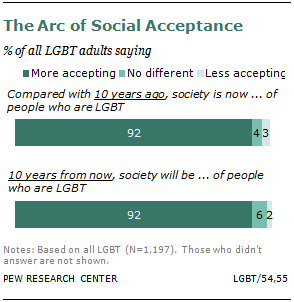 An overwhelming share of America's lesbian, gay, bisexual and transgender adults (92%) say guild has become more accepting of them in the past decade and an equal number expect it to grow even more accepting in the decade ahead. They attribute the changes to a diverseness of factors, from people knowing and interacting with someone who is LGBT, to advocacy on their behalf by high-profile public figures, to LGBT adults raising families.one
An overwhelming share of America's lesbian, gay, bisexual and transgender adults (92%) say guild has become more accepting of them in the past decade and an equal number expect it to grow even more accepting in the decade ahead. They attribute the changes to a diverseness of factors, from people knowing and interacting with someone who is LGBT, to advocacy on their behalf by high-profile public figures, to LGBT adults raising families.one
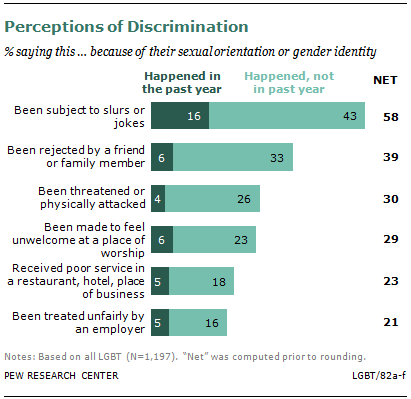 At the same fourth dimension, notwithstanding, a new nationally representative survey of i,197 LGBT adults offers testimony to the many ways they feel they accept been stigmatized by society. Almost four-in-ten (39%) say that at some point in their lives they were rejected past a family fellow member or close friend because of their sexual orientation or gender identity; 30% say they have been physically attacked or threatened; 29% say they have been made to feel unwelcome in a place of worship; and 21% say they take been treated unfairly past an employer. About half dozen-in-ten (58%) say they've been the target of slurs or jokes.
At the same fourth dimension, notwithstanding, a new nationally representative survey of i,197 LGBT adults offers testimony to the many ways they feel they accept been stigmatized by society. Almost four-in-ten (39%) say that at some point in their lives they were rejected past a family fellow member or close friend because of their sexual orientation or gender identity; 30% say they have been physically attacked or threatened; 29% say they have been made to feel unwelcome in a place of worship; and 21% say they take been treated unfairly past an employer. About half dozen-in-ten (58%) say they've been the target of slurs or jokes.
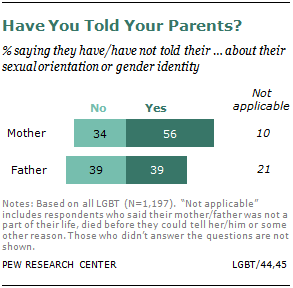 Also, just 56% say they have told their mother nigh their sexual orientation or gender identity, and 39% have told their father. Near who did tell a parent say that it was difficult, but relatively few say that information technology damaged their relationship.
Also, just 56% say they have told their mother nigh their sexual orientation or gender identity, and 39% have told their father. Near who did tell a parent say that it was difficult, but relatively few say that information technology damaged their relationship.
The survey finds that 12 is the median historic period at which lesbian, gay and bisexual adults first felt they might be something other than heterosexual or straight. For those who say they at present know for certain that they are lesbian, gay, bisexual or transgender, that realization came at a median age of 17.
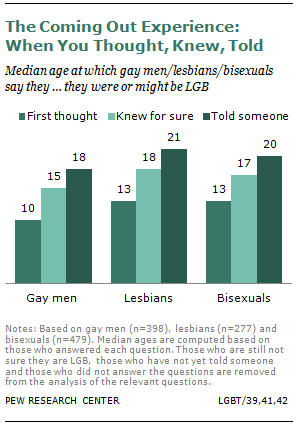 Among those who have shared this information with a family member or shut friend, twenty is the median historic period at which they offset did so.
Among those who have shared this information with a family member or shut friend, twenty is the median historic period at which they offset did so.
Gay men report having reached all of these coming out milestones somewhat earlier than do lesbians and bisexuals.
The survey was conducted April eleven-29, 2013, and administered online, a survey mode that enquiry indicates tends to produce more than honest answers on a range of sensitive topics than practise other less bearding modes of survey-taking. For more details, see Chapter 1 and Appendix 1.
The survey finds that the LGBT population is distinctive in many ways beyond sexual orientation. Compared with the full general public, Pew Inquiry LGBT survey respondents are more liberal, more Democratic, less religious, less happy with their lives, and more than satisfied with the general direction of the country. On boilerplate, they are younger than the general public. Their family incomes are lower, which may be related to their relative youth and the smaller size of their households. They are also more probable to perceive discrimination not merely against themselves but also against other groups with a legacy of discrimination.
About the Survey
Findings in this report are based on 2 chief information sources:
This report is based primarily on a Pew Inquiry Center survey of the LGBT population conducted Apr 11-29, 2013, amidst a nationally representative sample of 1,197 cocky-identified lesbian, gay, bisexual and transgender adults xviii years of age or older. The sample comprised 398 gay men, 277 lesbians, 479 bisexuals and 43 transgender adults. The survey questionnaire was written by the Pew Inquiry Center and administered by the GfK Group using KnowledgePanel, its nationally representative online inquiry panel.
The online survey manner was chosen for this study, in part, because considerable research on sensitive issues (such as drug use, sexual beliefs and even attendance at religious services) indicates that the online manner of survey administration is probable to elicit more honest answers from respondents on a range of topics.
The margin of sampling error for the full LGBT sample is plus or minus 4.i percentage points at the 95% confidence level. For more details on the LGBT survey methodology, see Appendix 1.
In near cases the comparisons made between LGBT adults and the general public are taken from other Pew Research Middle surveys.
Same-Sex Union
On the topic of same-sex union, non surprisingly, there is a large gap betwixt the views of the full general public and those of LGBT adults. Even though a record 51% of the public now favors assuasive gays and lesbians to marry legally, up from 32% in 2003, that share is still far below the 93% of LGBT adults who favor same-sexual practice marriage.
Despite nigh universal support for aforementioned-sex matrimony among LGBT adults, a meaning minority of that population—39%—say that the issue has drawn besides much attending abroad from other issues that are important to people who are LGBT. However, 58% say information technology should exist the top priority even if it takes attention away from other bug.
The survey finds that 16% of LGBT adults—mostly bisexuals with reverse-sexual activity partners—are currently married, compared with about half the adults in the general public. Overall, a total of lx% of LGBT survey respondents are either married or say they would like to marry one day, compared with 76% of the full general public.
Large majorities of LGBT adults and the full general public agree that dearest, companionship and making a lifelong delivery are very important reasons to marry. However LGBT survey respondents are twice as probable every bit those in the general public to say that obtaining legal rights and benefits is also a very important reason to marry (46% versus 23%). And the general public is more than likely than LGBT respondents to say that having children is a very of import reason to marry (49% versus 28%).
The LGBT Population and its Sub-Groups
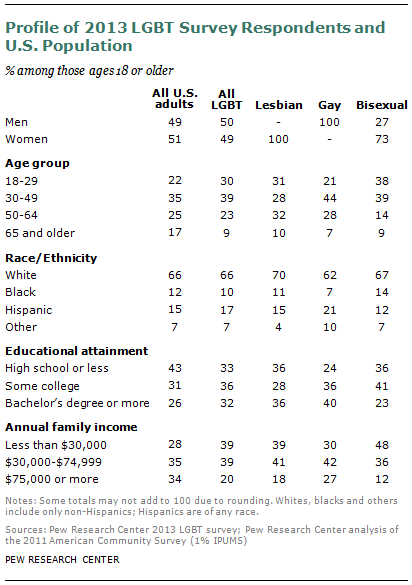 Four-in-ten respondents to the Pew Research Centre survey identify themselves as bisexual. Gay men are 36% of the sample, followed by lesbians (nineteen%) and transgender adults (5%).2 While these shares are consistent with findings from other surveys of the LGBT population, they should be treated with caution.3 At that place are many challenges in estimating the size and limerick of the LGBT population, starting with the question of whether to use a definition based solely on cocky-identification (the arroyo taken in this report) or whether to besides include measures of sexual attraction and sexual behavior.
Four-in-ten respondents to the Pew Research Centre survey identify themselves as bisexual. Gay men are 36% of the sample, followed by lesbians (nineteen%) and transgender adults (5%).2 While these shares are consistent with findings from other surveys of the LGBT population, they should be treated with caution.3 At that place are many challenges in estimating the size and limerick of the LGBT population, starting with the question of whether to use a definition based solely on cocky-identification (the arroyo taken in this report) or whether to besides include measures of sexual attraction and sexual behavior.
This report makes no attempt to estimate the share of the U.S. population that is LGBT. Other recent survey-based inquiry reports have made estimates in the 3.five% to 5% range. However, all such estimates depend to some caste on the willingness of LGBT individuals to disclose their sexual orientation and gender identity, and enquiry suggests that not everyone in this population is gear up or willing to do so. (See Appendix i for a discussion of these and other methodological issues).
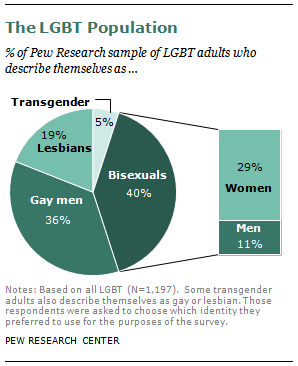 The table above provides a look at key demographic characteristics of the full Pew Research LGBT survey sample and its three largest sub-groups—bisexuals, gay men and lesbians. It shows, among other things, that bisexuals are younger, have lower family unit incomes and are less likely to be college graduates than gay men and lesbians. The relative youth of bisexuals probable explains some of their lower levels of income and didactics.
The table above provides a look at key demographic characteristics of the full Pew Research LGBT survey sample and its three largest sub-groups—bisexuals, gay men and lesbians. It shows, among other things, that bisexuals are younger, have lower family unit incomes and are less likely to be college graduates than gay men and lesbians. The relative youth of bisexuals probable explains some of their lower levels of income and didactics.
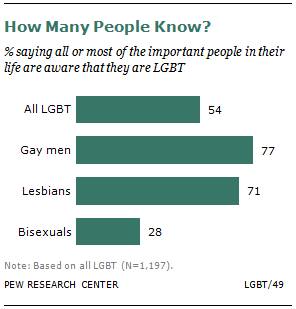 The survey as well finds that bisexuals differ from gay men and lesbians on a range of attitudes and experiences related to their sexual orientation. For case, while 77% of gay men and 71% of lesbians say almost or all of the important people in their lives know of their sexual orientation, just 28% of bisexuals say the aforementioned. Bisexual women are more likely to say this than bisexual men (33% vs. 12%). Likewise, about half of gay men and lesbians say their sexual orientation is extremely or very important to their overall identity, compared with just 2-in-ten bisexual men and women.
The survey as well finds that bisexuals differ from gay men and lesbians on a range of attitudes and experiences related to their sexual orientation. For case, while 77% of gay men and 71% of lesbians say almost or all of the important people in their lives know of their sexual orientation, just 28% of bisexuals say the aforementioned. Bisexual women are more likely to say this than bisexual men (33% vs. 12%). Likewise, about half of gay men and lesbians say their sexual orientation is extremely or very important to their overall identity, compared with just 2-in-ten bisexual men and women.
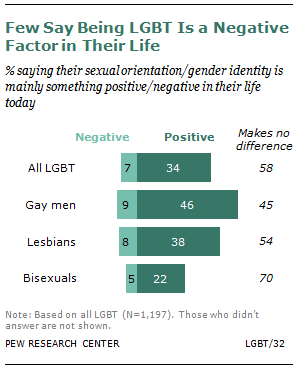 Gays and lesbians are also more likely than bisexuals to say their sexual orientation is a positive cistron in their lives, though across all three subgroups, many say it is neither positive nor negative. Only a small-scale fraction of all groups describe their sexual orientation or gender identity as a negative gene.
Gays and lesbians are also more likely than bisexuals to say their sexual orientation is a positive cistron in their lives, though across all three subgroups, many say it is neither positive nor negative. Only a small-scale fraction of all groups describe their sexual orientation or gender identity as a negative gene.
Roughly 3-quarters of bisexual respondents to the Pew Research survey are women. By contrast, gay men outnumber lesbians by nearly two-to-i among survey respondents. Bisexuals are far more likely than either gay men or lesbians to be married, in part because a large bulk of those in committed relationships take partners of the opposite sex and thus are able to marry legally. Also, two-thirds of bisexuals say they either already have or want children, compared with about half of lesbians and three-in-ten gay men.
Across the LGBT population, more say bisexual women and lesbians are accepted by society than say this about gay men, bisexual men or transgender people. 1-in-4 respondents say there is a lot of social acceptance of lesbians, while just 15% say the aforementioned almost gay men. Similarly, in that location is more perceived acceptance of bisexual women (33% a lot) than of bisexual men (viii%). Transgender adults are viewed as less accustomed by social club than other LGBT groups: merely 3% of survey respondents say there is a lot of credence of this group.
Social Acceptance and the Public'southward Perspective
Even though most LGBT adults say there has been significant progress toward social acceptance, relatively few (nineteen%) say in that location is a lot of social credence for the LGBT population today. A bulk (59%) says there is some, and 21% say at that place is little or no credence today.
Surveys of the general public show that societal acceptance is on the rise. More Americans now say they favor same-sex marriage and fewer say homosexuality should be discouraged, compared with a decade ago. These changing attitudes may be due in part to the fact that a growing share of all adults say they personally know someone who is gay or lesbian—87% today, up from 61% in 1993.
A new Pew Research Eye analysis shows that among the full general public, knowing someone who is gay or lesbian is linked with greater credence of homosexuality and back up for same-sex spousal relationship.
LGBT adults themselves recognize the value of these personal interactions; 70% say people knowing someone who is LGBT helps a lot in terms of making social club more than accepting of the LGBT population.
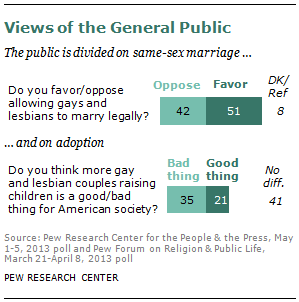 Yet, a significant share of the public believes that homosexuality should be discouraged and that same-sex union should not be legal. Much of this resistance is rooted in deeply held religious attitudes, such equally the conventionalities that engaging in homosexual behavior is a sin.
Yet, a significant share of the public believes that homosexuality should be discouraged and that same-sex union should not be legal. Much of this resistance is rooted in deeply held religious attitudes, such equally the conventionalities that engaging in homosexual behavior is a sin.
And the public is conflicted most how the rising share of gays and lesbians raising children is affecting society. Simply 21% of all adults say this trend is a good thing for lodge, 35% say this is a bad thing for society, and 41% say information technology doesn't make much divergence. The share maxim this is a bad matter has fallen significantly in recent years (from 50% in 2007).
The Coming Out Process
In the context of limited only growing acceptance of the LGBT population, many LGBT adults have struggled with how and when to tell others well-nigh their sexual orientation. Nigh six-in-x (59%) have told one or both of their parents, and a bulk say most of the people who are important to them know almost this aspect of their life.
Most of those who take told their parents say this process wasn't like shooting fish in a barrel. Some 59% of those who have told their mother about their sexual orientation or gender identity and 65% who have told their father say it was difficult to share this information. However, of those who have told their mothers, the vast majority say it either made the human relationship stronger (39%) or didn't alter the relationship (46%). A similar-sized majority says telling their father about their sexual orientation or gender identity didn't hurt their relationship.
Age, Gender and Race
The survey finds that the attitudes and experiences of younger adults into the LGBT population differ in a variety of ways from those of older adults, maybe a reflection of the more accepting social milieu in which younger adults have come of historic period.
For example, younger gay men and lesbians are more than likely to take disclosed their sexual orientation somewhat before in life than take their older counterparts. Some of this deviation may be attributable to changing social norms, but some is owing to the fact that the experiences of young adults who take non notwithstanding identified every bit being gay or lesbian but volition do so subsequently in life cannot be captured in this survey.
As for gender patterns, the survey finds that lesbians are more probable than gay men to be in a committed relationship (66% versus forty%); also, bisexual women are much more than likely than bisexual men to be in one of these relationships (68% versus 40%). In add-on women, whether lesbian or bisexual, are significantly more likely than men to either already take children or to say they want to have children one day.
Among survey respondents, whites are more likely than non-whites to say society is a lot more accepting of LGBT adults at present than it was a decade ago (58% vs. 42%) and, past a similar margin, are more optimistic most futurity levels of acceptance.4 Not-whites are more likely than whites to say beingness LGBT is extremely or very important to their overall identity (44% versus 34%) and more likely every bit well to say at that place is a conflict between their religion and their sexual orientation (37% versus 20%).
Views of Bug, Leaders, Institutions
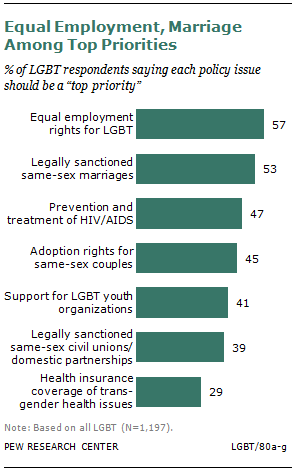 On the eve of a ruling expected later this month by the U.S. Supreme Courtroom on two aforementioned-sex activity marriage cases, 58% of LGBT adults say they have a favorable view of the court and 40% view information technology unfavorably; these assessments are similar to those held past the general public.
On the eve of a ruling expected later this month by the U.S. Supreme Courtroom on two aforementioned-sex activity marriage cases, 58% of LGBT adults say they have a favorable view of the court and 40% view information technology unfavorably; these assessments are similar to those held past the general public.
While the same-sex marriage issue has dominated news coverage of the LGBT population in recent years, it is only one of several top priority bug identified past survey respondents. Other tiptop rank issues include employment rights, HIV and AIDS prevention and treatment, and adoption rights.
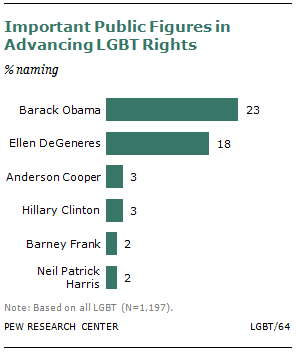 When asked in an open-ended question to name the national public figures most responsible for advancing LGBT rights, President Barack Obama, who announced last year that he had changed his mind and supports gay marriage, tops the list along with comedian and talk show host Ellen DeGeneres, who came out every bit a lesbian in 1997 and has been a leading advocate for the LGBT population ever since and then. Some 23% of respondents named Obama and 18% named DeGeneres. No one else was named by more 3% of survey respondents.
When asked in an open-ended question to name the national public figures most responsible for advancing LGBT rights, President Barack Obama, who announced last year that he had changed his mind and supports gay marriage, tops the list along with comedian and talk show host Ellen DeGeneres, who came out every bit a lesbian in 1997 and has been a leading advocate for the LGBT population ever since and then. Some 23% of respondents named Obama and 18% named DeGeneres. No one else was named by more 3% of survey respondents.
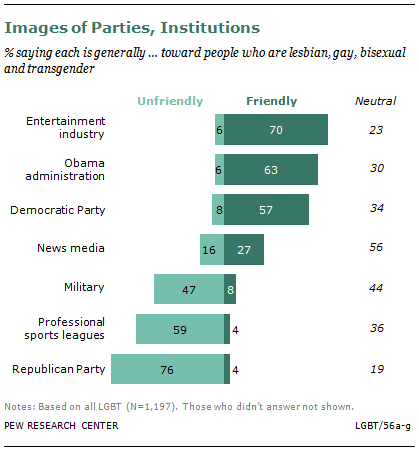 For the most function LGBT adults are in broad agreement on which institutions they consider friendly to people who are lesbian, gay, bisexual and transgender. 7-in-ten describe the entertainment manufacture as friendly, 63% say the same most the Obama administration, and 57% view the Autonomous Party as friendly. Past dissimilarity, just four% say the aforementioned about the Republican Party (compared with 76% who say it is unfriendly); 8% about the military machine (47% unfriendly) and iv% about professional sports leagues (59% unfriendly). LGBT adults have mixed views about the news media, with 27% proverb it is friendly, 56% neutral and sixteen% unfriendly.
For the most function LGBT adults are in broad agreement on which institutions they consider friendly to people who are lesbian, gay, bisexual and transgender. 7-in-ten describe the entertainment manufacture as friendly, 63% say the same most the Obama administration, and 57% view the Autonomous Party as friendly. Past dissimilarity, just four% say the aforementioned about the Republican Party (compared with 76% who say it is unfriendly); 8% about the military machine (47% unfriendly) and iv% about professional sports leagues (59% unfriendly). LGBT adults have mixed views about the news media, with 27% proverb it is friendly, 56% neutral and sixteen% unfriendly.
LGBT survey respondents are far more Democratic than the general public—about eight-in-x (79%) are Democrats or lean to the Democratic Party, compared with 49% of the full general public. And they offer opinions on a range of public policy bug that are in sync with the Autonomous and liberal tilt to their partisanship and credo. For instance, they are more likely than the full general public to say they back up a bigger government that provides more services (56% versus 40%); they are more supportive of gun command (64% versus l%) and they are more likely to say immigrants strengthen the state (62% versus 49%).
Cocky and State
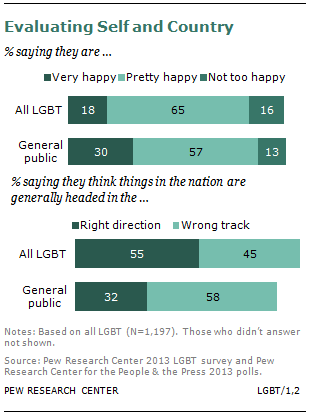 LGBT adults and the general public are as well notably unlike in the ways they evaluate their personal happiness and the overall management of the state.
LGBT adults and the general public are as well notably unlike in the ways they evaluate their personal happiness and the overall management of the state.
In the instance of happiness, only eighteen% of LGBT adults describe themselves as "very happy," compared with xxx% of adults in the general public who say the same. Gay men, lesbians and bisexuals are roughly equal in their expressed level of happiness.
When it comes to evaluations of the direction of the nation, the pattern reverses, with LBGT adults more inclined than the general public (55% versus 32%) to say the country is headed in the right management. Opinions on this question are strongly associated with partisanship.
Faith
Religion is a difficult terrain for many LGBT adults. Lopsided majorities describe the Muslim organized religion (84%), the Mormon Church (83%), the Catholic Church (79%) and evangelical churches (73%) as unfriendly toward people who are LGBT. They have more mixed views of the Jewish faith and mainline Protestant churches, with fewer than half of LGBT adults describing those religions every bit unfriendly, one-in-ten describing each of them as friendly and the rest saying they are neutral.
The survey finds that LGBT adults are less religious than the general public. Roughly one-half (48%) say they accept no religious affiliation, compared with 20% of the public at big. Of those LGBT adults who are religiously affiliated, one-third say there is a conflict between their religious beliefs and their sexual orientation or gender identity. And among all LGBT adults, about iii-in-x (29%) say they accept been made to feel unwelcome in a place of worship.
 Pew Research surveys of the full general public show that while societal views about homosexuality have shifted dramatically over the past decade, highly religious Americans remain more likely than others to believe that homosexuality should be discouraged rather than accepted by gild. And among those who attend religious services weekly or more frequently, fully two-thirds say that homosexuality conflicts with their religious beliefs (with 50% saying there is a great deal of conflict). In add-on, religious commitment is strongly correlated with opposition to same-sex marriage.
Pew Research surveys of the full general public show that while societal views about homosexuality have shifted dramatically over the past decade, highly religious Americans remain more likely than others to believe that homosexuality should be discouraged rather than accepted by gild. And among those who attend religious services weekly or more frequently, fully two-thirds say that homosexuality conflicts with their religious beliefs (with 50% saying there is a great deal of conflict). In add-on, religious commitment is strongly correlated with opposition to same-sex marriage.
Community Identity and Engagement
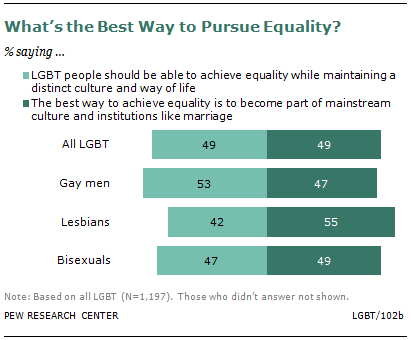 As LGBT adults become more accepted by club, the survey finds different points of view about how fully they should seek to become integrated into the broader culture. About half of survey respondents (49%) say the best way to accomplish equality is to get a part of mainstream culture and institutions such as marriage, but an equal share say LGBT adults should be able to achieve equality while however maintaining their ain distinct civilisation and manner of life.
As LGBT adults become more accepted by club, the survey finds different points of view about how fully they should seek to become integrated into the broader culture. About half of survey respondents (49%) say the best way to accomplish equality is to get a part of mainstream culture and institutions such as marriage, but an equal share say LGBT adults should be able to achieve equality while however maintaining their ain distinct civilisation and manner of life.
Likewise, there are divisions between those who say it is important to maintain places like LGBT neighborhoods and bars (56%) and those who feel these venues will become less important over time (41%). Gay men are most likely of any of the LGBT subgroups to say that these distinctive venues should be maintained (68%).
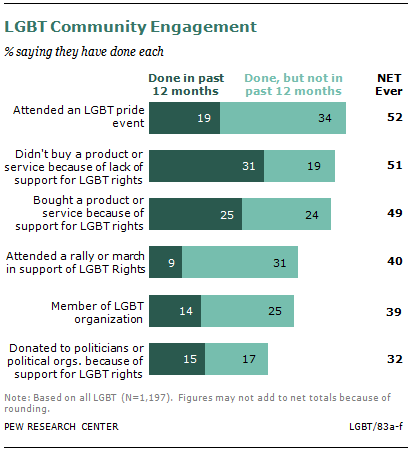 When it comes to community engagement, gay men and lesbians are more involved than bisexuals in a variety of LGBT-specific activities, such as attending a gay pride event or being a member of an LGBT organization.
When it comes to community engagement, gay men and lesbians are more involved than bisexuals in a variety of LGBT-specific activities, such as attending a gay pride event or being a member of an LGBT organization.
Overall, many LGBT adults say they have used their economic power in support or opposition to sure products or companies. About half (51%) say they accept not bought a production or service because the visitor that provides information technology is not supportive of LGBT rights. A similar share (49%) says they have specifically bought a product or service because the visitor is supportive of LGBT rights.
Some 52% take attended an LGBT pride outcome, and 40% have attended a rally or march in back up of LGBT rights. About 4-in-10 (39%) say they belong to an LGBT organisation and roughly 3-in-ten (31%) have donated money to politicians who back up their rights.
LGBT Adults Online
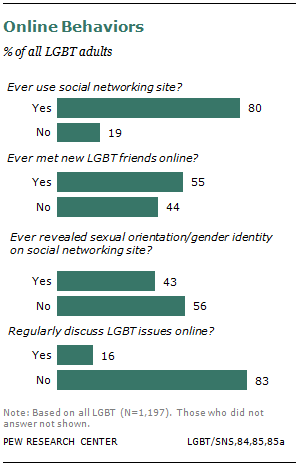 LGBT adults are heavy users of social networking sites, with 8o% of survey respondents proverb they accept used a site such equally Facebook or Twitter. This compares with 58% of the general public (and 68% of all internet users), a gap largely attributable to the fact that as a group LGBT adults are younger than the general public, and immature adults are much more likely than older adults to use social networking sites. When young LGBT adults are compared with all young adults, the share using these sites is nigh identical (89% of LGBT adults ages 18 to 29 vs. xc% of all adults ages 18 to 29).
LGBT adults are heavy users of social networking sites, with 8o% of survey respondents proverb they accept used a site such equally Facebook or Twitter. This compares with 58% of the general public (and 68% of all internet users), a gap largely attributable to the fact that as a group LGBT adults are younger than the general public, and immature adults are much more likely than older adults to use social networking sites. When young LGBT adults are compared with all young adults, the share using these sites is nigh identical (89% of LGBT adults ages 18 to 29 vs. xc% of all adults ages 18 to 29).
There are big differences beyond LGBT groups in how they use social networking sites. Amid all LGBT adults, 55% say they accept met new LGBT friends online or through a social networking site. Gay men are the about likely to say they have done this (69%). By contrast, about half of lesbians (47%) and bisexuals (49%) say they take met a new LGBT friend online.
Nearly four-in-ten LGBT adults (43%) take revealed their sexual orientation or gender identity on a social networking site. While roughly half of gay men and lesbians have come out on a social network, only almost one-third (34%) of bisexuals say they take done this.
Just sixteen% say they regularly discuss LGBT issues online; 83% say they do not practise this.
A Notation on Transgender Respondents
Transgender is an umbrella term that groups together a variety of people whose gender identity or gender expression differs from their birth sex. Some identify every bit female-to-male, others as male-to-female person. Others may call themselves gender non-conforming, reflecting an identity that differs from social expectations most gender based on birth sexual activity. Some may call themselves genderqueer, reflecting an identity that may exist neither male nor female. And others may use the term transsexual to describe their identity. A transgender identity is not dependent upon medical procedures. While some transgender individuals may choose to alter their bodies through surgery or hormonal therapy, many transgender people choose not to do so.
People who are transgender may also describe themselves every bit heterosexual, gay, lesbian, or bisexual. In the Pew Research Center survey, respondents were asked whether they considered themselves to exist transgender in a separate serial of questions from the question nigh whether they considered themselves to be lesbian, gay, bisexual, or heterosexual (see Appendix 1 for more details).
The Pew Inquiry survey finds that 5% of LGBT respondents identify primarily as transgender; this is roughly consistent with other estimates of the proportion of the LGBT population that is transgender. Although there is limited information on the size of the transgender population, information technology is estimated that 0.3% of all American adults are transgender (Gates 2011).
Because of the small number of transgender respondents in this survey (northward=43), it is not possible to generate statistically meaning findings about the views of this subgroup. However, their survey responses are represented in the findings about the full LGBT population throughout the survey.
The responses to both open up- and closed-ended questions do let for a few general findings. For example, amongst transgender respondents to this survey, most say they first felt their gender was different from their birth sex before puberty. For many, beingness transgender is a cadre part of their overall identity, fifty-fifty if they may not widely share this with many people in their lives.
And just equally gay men, lesbians, and bisexuals perceive less commonality with transgender people than with each other, transgender adults may appear not to perceive a great deal of commonality with lesbians, gay men, and bisexuals. In particular, issues like same-sex marriage may exist viewed as less important by this group, and transgender adults appear to be less involved in the LGBT customs than are other sub-groups.
Here are some of the voices of transgender adults in the survey:
Voices: Transgender Survey Respondents
On Gender Identity
"It finally feels comfortable to be in my own body and head—I can be who I am, finally."
–Transgender adult, age 24
"I take suffered most of my life in the wrong gender. Now I feel more than at domicile in the world, though I must admit, not completely. There is still enough of phobic feeling."
–Transgender developed, historic period 77
"Though I have non transitioned fully, being born every bit male person but viewing things from a female person perspective gives me a perspective from both vantage points. I am very empathetic because of my circumstance."
–Transgender adult, age 56
"I wish I could accept identified solely as male. Identifying as some other gender is not piece of cake."
–Transgender adult, age 49
On Telling People
"Times were unlike for in-between kids born in the xxx'south. We generally tried to conform and simply lived two lives at in one case. The stress acquired a very loftier suicide rate and a higher charge per unit of booze addiction (somehow I was spared both.)"
-Transgender developed, age 77
"It'due south been difficult and very cleansing at the same fourth dimension. The hardest role is telling old friends because they've known you lot for so long as your built-in gender. But most people are willing to change for you lot if they care enough." –Transgender adult, age 27
"I take only told close members of my family and only a handful of friends. I don't think that it is important to shout it out from the rooftops, especially in my profession."
–Transgender adult, age 38
"This process is difficult. Most people know me ane way and to talk to them about a dissimilar side of me can be disconcerting. I have not told most people because of my continuing in the community and my job, which could be in jeopardy"
–Transgender adult, historic period 44
"Some of my family still refers to me as "she" but when we get out they catch themselves because of how I look, they audio foolish to strangers :). When it's a bunch of family or old friends, they unremarkably don't assign me a gender they say my proper noun. Only I don't get likewise bothered by information technology, they are family and well, that'due south a huge thing to have to change in your mind. For the ones that exercise information technology out of boldness, I but talk to them one on i and ask for them to practice better." –Transgender adult, age 29
LGBT/32a,50
Notes on Terminology
Unless otherwise noted, all references to whites, blacks and others are to the non-Hispanic components of those populations. Hispanics can be of whatsoever race. Non-whites refers to people whose race is not white (e.k. black, Asian, etc.) or to Hispanics regardless of their race.
Throughout this report, the acronym "LGBT" is used to refer to the lesbian, gay, bisexual and transgender population. The phrases "LGBT adults," "LGBT individuals," "LGBT people" and "LGBT respondents" are used interchangeably throughout this report every bit are the phrases "LGBT population" and "LGBT customs."
In the survey instrument, when LGBT adults were asked nigh their identity, gays, lesbians and bisexuals were asked about their sexual orientation while transgender respondents were asked about their gender identity. This protocol is too used in the report when reporting LGBT adults' views of their identity.
References to the political party identification of respondents include those who identify with a political political party or lean towards a specific political party. Those identified as independents do not lean towards either the Democratic Political party or the Republican Party.
Acknowledgments
Many Pew Research Middle staff members contributed to this research project. Paul Taylor oversaw the projection and served as lead editor of the report. Kim Parker, Jocelyn Kiley and Mark Hugo Lopez took the pb in the development of the LGBT survey instrument. Scott Keeter managed development of the survey's methodological strategy.
The report's overview was written past Taylor. Affiliate 1 of the written report was written past D'Vera Cohn and Gretchen Livingston. Parker wrote capacity two and iii. Chapter four was written by Eileen Patten. Chapter v was written by Kiley and Patten. Cary Funk and Rich Morin wrote Chapter 6 of the report. Kiley wrote Chapter seven. Keeter wrote the report's methodology appendix. Lopez, Patten, Kiley, Sara Goo, Adam Nekola and Meredith Dost curated quotes for the "voices" features and online interactive. The report was number checked by Anna Brownish, Danielle Cuddington, Matthew Frei, Seth Motel, Patten, Rob Suls, Alec Tyson and Wendy Wang. Noble Kuriakose and Besheer Mohamed provided information analysis for the report'southward demographic affiliate. The report was re-create-edited past Marcia Kramer of Kramer Editing Services and Molly Rohal.
Others at the Pew Research Eye who provided editorial or enquiry guidance include Alan Murray, Michael Dimock, Carroll Doherty, Andrew Kohut, Alan Cooperman, Lee Rainie and James Hawkins.
Staffers who helped to disseminate the report and to prepare related online content include Goo, Vidya Krishnamurthy, Michael Piccorossi, Russ Oates, Adam Nekola, Diana Yoo, Michael Suh, Andrea Caumont, Michael Keegan, Jessica Schillinger, Bruce Drake, Caroline Klibanoff, Rohal, Russell Heimlich and Katie Reilly.
The Pew Research Center thank you and acknowledges M.V. Lee Badgett and Gary J. Gates. Badgett is the Managing director of the Center for Public Policy & Administration and Professor of economic science at the University of Massachusetts, Amherst. She is besides the research managing director of UCLA'south Williams Institute. Gates is the Williams Distinguished Scholar at UCLA's Williams Institute. They served as advisors to the projection, providing invaluable guidance on survey questionnaire development, demographic analysis of U.South. Census Bureau data and the survey'southward methodology. We besides give thanks Stephanie Jwo, Joseph Garrett and Monsour Fahimi of the GfK Grouping, who worked with Keeter on the survey's sampling design, information collection protocol and weighting plan and oversaw the collection of the data; and Frank Newport of Gallup, who provided comparative data from Gallup's surveys.
The Pew Research Eye conducted a focus group discussion on March 26, 2013 in Washington, D.C. to assist inform the survey questionnaire'south evolution. The focus group was chastened by Lopez and was equanimous of 12 individuals ages 18 and older. Participants were told that what they said might be quoted in the report or other products from the Pew Research Eye, but that they would not be identified by proper noun.
Roadmap to the Report
Chapter 1, Demographic Portrait and Research Challenges, examines the demographic profile of lesbian, gay, bisexual and transgender adults surveyed by the Pew Enquiry Center and other prominent inquiry organizations. Information technology as well includes data on aforementioned-sex couples from the U.Due south. Census Bureau. In addition, this chapter discusses the challenges involved in surveying this population and making estimates about its size and characteristics.
Chapter two, Social Credence, looks at societal views of the LGBT population from the perspective of LGBT adults themselves. Information technology also chronicles the ways in which LGBT adults take experienced discrimination in their ain lives and looks at the extent to which they believe major institutions in this land are accepting of them.
Chapter 3, The Coming Out Experience, chronicles the journeying LGBT adults accept been on in realizing their sexual orientation or gender identity and sharing that information with family and friends. It besides looks at where LGBT adults live, how many of their friends are LGBT and whether they are open nigh their LGBT identity at piece of work. This chapter includes a cursory section on online habits and behaviors.
Chapter 4, Spousal relationship and Parenting, looks at LGBT adults' attitudes toward same-sex marriage and also their experiences in the realm of family life. Information technology examines their relationship status and their desire to marry and take children—detailing the key differences across LGBT groups and between LGBT adults and the general public.
Chapter v, Identity and Community, explores how LGBT adults view their sexual orientation or gender identity in the context of their overall identity. It looks at the extent to which this aspect of their lives is cardinal to who they are, as well as how much they experience they have in mutual with other LGBT adults. Information technology also looks at the extent to which LGBT adults are engaged in the broader LGBT community and how they view the remainder betwixt maintaining a distinct LGBT culture and becoming part of the American mainstream.
Affiliate vi, Faith, details the religious affiliation, beliefs and practices of LGBT adults and compares them with those of the full general public. Information technology besides looks at whether LGBT adults feel their religious beliefs are in conflict with their sexual orientation or gender identity, and how they experience they are perceived by diverse religious groups and institutions.
Affiliate 7, Partisanship, Policy Views, Values, looks at the political party affiliation of LGBT adults and their views of Barack Obama and of the Democratic and Republican parties. It likewise includes LGBT views on key policy bug, such every bit immigration and gun control, and compares them with those of the full general public. And it too looks at how LGBT adults prioritize LGBT-related policy issues beyond same-sex union.
Post-obit the survey chapters is a detailed survey methodology argument. This includes descriptions of the sampling frame, questionnaire evolution and weighting procedures for the LGBT survey. It also has a demographic profile of the Pew Research LGBT survey respondents with details on specific LGBT groups.
Interspersed throughout the report are Voices of LGBT adults. These are quotes from open up-ended questions included in the survey and are meant to personalize the aggregate findings and add richness and nuance. Individual respondents are identified but by their age, gender and sexual orientation or gender identity. Additional quotes from LGBT respondents are available in an interactive feature on the Pew Research Middle website.
kirbywitroubt1946.blogspot.com
Source: https://www.pewresearch.org/social-trends/2013/06/13/a-survey-of-lgbt-americans/
0 Response to "Did You Know 1 Out of 3 People Are Gay Meme"
Postar um comentário